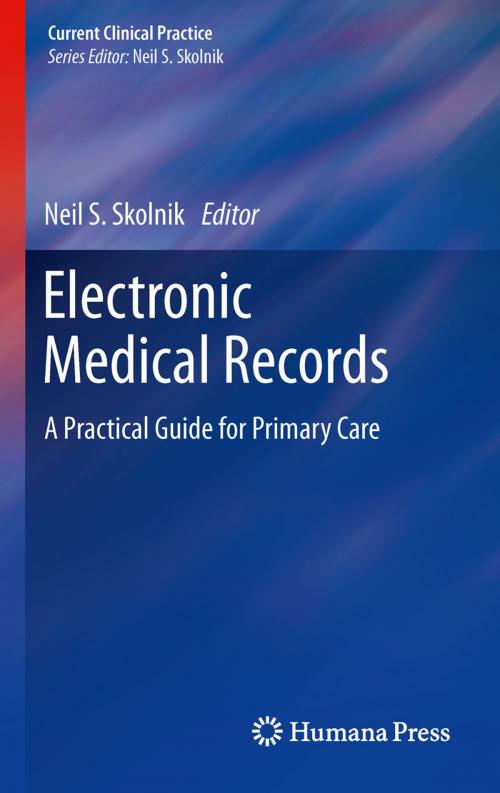Electronic Medical Records
A Practical Guide for Primary Care
Nonfiction, Health & Well Being, Medical, Specialties, Family & General Practice, Internal Medicine, General| Author: | ISBN: | 9781607616061 | |
| Publisher: | Humana Press | Publication: | October 20, 2010 |
| Imprint: | Humana | Language: | English |
| Author: | |
| ISBN: | 9781607616061 |
| Publisher: | Humana Press |
| Publication: | October 20, 2010 |
| Imprint: | Humana |
| Language: | English |
Physician adoption of electronic medical records (EMRs) has become a national priority. It is said that EMRs have the potential to greatly improve patient care, to provide the data needed for more effective population management and quality assurance of both an individual practice’s patients and well as patients of large health care systems, and the potential to create efficiencies that allow physicians to provide this improved care at a far lower cost than at present. There is currently a strong U.S. government push for physicians to adopt EMR technology, with the Obama administration emphasizing the use of EMRs as an important part of the future of health care and urging widespread adoption of this technology by 2014. This timely book for the primary care community offers a concise and easy to read guide for implementing an EMR system. Organized in six sections, this invaluable title details the general state of the EMR landscape, covering the government’s incentive program, promises and pitfalls of EMR technology, issues related to standardization and the range of EMR vendors from which a provider can choose. Importantly, chapter two provides a detailed and highly instructional account of the experiences that a range of primary care providers have had in implementing EMR systems. Chapter three discusses how to effectively choose an EMR system, while chapters four and five cover all of the vital pre-implementation and implementation issues in establishing an EMR system in the primary care environment. Finally, chapter six discusses how to optimize and maintain a new EMR system to achieve the full cost savings desired. Concise, direct, but above all honest in recognizing the challenges in choosing and implementing an electronic health record in primary care, Electronic Medical Records: A Practical Guide for Primary Care has been written with the busy primary care physician in mind.
Physician adoption of electronic medical records (EMRs) has become a national priority. It is said that EMRs have the potential to greatly improve patient care, to provide the data needed for more effective population management and quality assurance of both an individual practice’s patients and well as patients of large health care systems, and the potential to create efficiencies that allow physicians to provide this improved care at a far lower cost than at present. There is currently a strong U.S. government push for physicians to adopt EMR technology, with the Obama administration emphasizing the use of EMRs as an important part of the future of health care and urging widespread adoption of this technology by 2014. This timely book for the primary care community offers a concise and easy to read guide for implementing an EMR system. Organized in six sections, this invaluable title details the general state of the EMR landscape, covering the government’s incentive program, promises and pitfalls of EMR technology, issues related to standardization and the range of EMR vendors from which a provider can choose. Importantly, chapter two provides a detailed and highly instructional account of the experiences that a range of primary care providers have had in implementing EMR systems. Chapter three discusses how to effectively choose an EMR system, while chapters four and five cover all of the vital pre-implementation and implementation issues in establishing an EMR system in the primary care environment. Finally, chapter six discusses how to optimize and maintain a new EMR system to achieve the full cost savings desired. Concise, direct, but above all honest in recognizing the challenges in choosing and implementing an electronic health record in primary care, Electronic Medical Records: A Practical Guide for Primary Care has been written with the busy primary care physician in mind.















